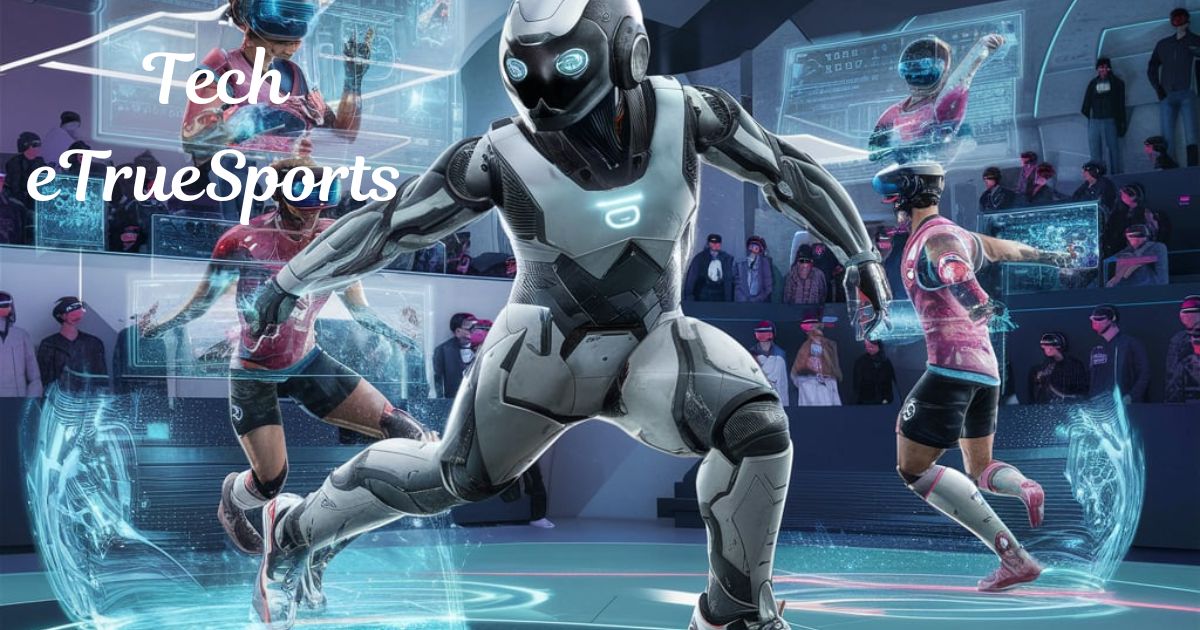In the heart of Silicon Valley and beyond, a new phenomenon is taking the USA by storm. Tech eTrueSports – the thrilling convergence of cutting-edge technology and competitive gaming – is reshaping how Americans play, watch, and interact with video games.
This blog post delves deep into the world of Tech eTrueSports, exploring its evolution, current state, and the exciting future that lies ahead.
The Evolution of Tech eTrueSports: From Arcades to Global Arenas
The journey of Tech eTrueSports began in dimly lit arcades and basement LAN parties, where friends gathered to compete in pixelated battles. But as technology advanced, so did the scope and scale of competitive gaming.
The late 1990s and early 2000s saw the rise of online multiplayer games that would become the cornerstones of modern esports.
Games like the game StarCraft, the Counter-Strike Online, and Warcraft game III paved the way for a new era of competition. These titles didn’t just offer entertainment; they became digital sports, complete with professional players, teams, and international tournaments.
The USA, with its tech-savvy population and entrepreneurial spirit, quickly became a hotbed for this burgeoning industry.
“Esports isn’t just about playing games; it’s about pushing the boundaries of human performance in the digital realm.” – Sundance DiGiovanni, Co-founder of Major League Gaming
As internet speeds increased and hardware capabilities expanded, the esports scene exploded. American companies like Twitch (now owned by Amazon) revolutionized how fans could watch and interact with their favorite players and teams.
The advent of streaming platforms turned bedroom gamers into household names, and esports events began filling stadiums across the nation.
The Rise of Professional Gaming

The Rise of Professional Gaming
With the growth of Tech eTrueSports came the emergence of professional gaming as a viable career path. Today, top players in the USA can earn millions of dollars through tournament winnings, sponsorships, and streaming revenue.
Organizations like Team Liquid, Cloud9, and FaZe Clan have become household names, operating more like traditional sports franchises with training facilities, coaches, and support staff.
This professionalization has led to a more structured ecosystem, with leagues like the Overwatch League and the League of Legends Championship Series adopting city-based franchise models similar to traditional American sports leagues.
These developments have not only legitimized esports in the eyes of mainstream audiences but have also attracted significant investment from traditional sports figures and venture capitalists.
Hardware: The Backbone of Tech eTrueSports
The evolution of gaming hardware has been nothing short of remarkable. Today’s gaming rigs are light-years ahead of the clunky desktop PCs of yesteryear. Let’s break down the key components driving this hardware revolution:
- Processors: Multi-core CPUs from Intel and AMD process millions of calculations per second.
- Graphics Cards: NVIDIA and AMD GPUs render hyper-realistic environments in real-time.
- Memory: High-speed RAM and SSDs minimize loading times and improve overall performance.
- Cooling Systems: Advanced liquid cooling keeps hardware running at peak efficiency during intense gaming sessions.
But it’s not just about PCs. Consoles like the Xbox System X and PlayStation 5 have brought near-PC levels of performance to the living room. These machines offer features like ray tracing, 4K resolution, and high frame rates, making the line between console and PC gaming increasingly blurry.
Peripherals, too, have undergone a tech-driven transformation. Pro gamers now use mice with adjustable weights, mechanical keyboards with customizable actuation points, and headsets with 3D audio positioning. These devices offer minute advantages that can make all the difference in high-stakes tournaments.
The Impact of Hardware Innovations
The rapid advancement of gaming hardware has had far-reaching effects on the Tech eTrueSports landscape:
- Improved Spectator Experience: Higher resolutions and frame rates make games more visually appealing and easier to follow for viewers.
- Expanded Game Design Possibilities: More powerful hardware allows developers to create more complex and immersive game worlds.
- Reduced Barriers to Entry: As technology becomes more affordable, more players can access high-performance gaming setups.
- Cross-Platform Play: Increased hardware parity between PCs and consoles is making cross-platform competitions more viable.
Software: The Brains Behind the Operation
While hardware provides the muscle, software is the brains of Tech eTrueSports. Game developers are constantly pushing the envelope, creating more realistic, balanced, and engaging competitive experiences.
American companies like Riot Games (League of Legends) and Blizzard Entertainment (Overwatch) have become global leaders in esports game development. These games aren’t just entertainment; they’re complex ecosystems that require constant balancing and updating to maintain a fair and exciting competitive environment.
Behind the scenes, sophisticated matchmaking algorithms ensure players are pitted against opponents of similar skill levels. Anti-cheat systems work tirelessly to maintain the integrity of competitions. And data analytics tools provide players and teams with insights that would make traditional sports analysts green with envy.
The Role of AI in Game Development

The Role of AI in Game Development
Artificial Intelligence is playing an increasingly important role in the development and maintenance of esports titles. ‘Lows Adventure 2‘ is one such example. Here are some key applications:
- Balancing: AI models can analyze vast amounts of game data to identify overpowered strategies or characters.
- Player Behavior: Machine learning algorithms can detect toxic behavior and cheating more effectively than ever before.
- Personalized Experiences: AI can tailor in-game experiences to individual players, keeping them engaged and challenged.
- NPC Behavior: Advanced AI is creating more realistic and challenging computer-controlled opponents for practice and single-player modes.
Networking: The Lifeline of Tech eTrueSports
In the world of Tech eTrueSports, milliseconds matter. That’s why networking technology has been a crucial area of innovation.
The rollout of 5G connections across the USA is set to revolutionize mobile gaming, offering ultra-low latency and high bandwidth that could make competitive mobile esports a reality.
Cloud gaming services are also changing the game. Platforms like Google Stadia and Amazon Luna are making high-end gaming accessible to anyone with a decent internet connection, potentially democratizing access to Tech eTrueSports.
The Promise of Edge Computing
Edge computing is emerging as a game-changer for Tech eTrueSports. By processing data closer to the source, edge computing can drastically reduce latency, a critical factor in competitive gaming. This technology could enable:
- Hyper-Local Tournaments: Allowing for ultra-low latency competitions in specific geographic areas.
- Improved Mobile Gaming: Enhancing the performance of competitive mobile games.
- VR/AR Integration: Supporting the data-intensive requirements of virtual and augmented reality esports.
The Rise of Streaming and Content Creation
Platforms like Twitch, YouTube Games, and Facebook’s Gaming page have become the ESPN of Tech eTrueSports.
These platforms don’t just broadcast games; they’ve created entire ecosystems where fans can interact with their favorite players, discuss strategies, and even influence the outcome of events through chat interactions.
Here’s a breakdown of the top streaming platforms in the USA:
| Platform | Monthly Active Users | Top Game | Unique Feature |
| Twitch | 140 million | League of Legends | Twitch Prime |
| YouTube Gaming | 100 million | Minecraft | Integrated with YouTube |
| Facebook Gaming | 380 million | PUBG Mobile | Integrated with Facebook |
The Content Creator Economy
The rise of Tech eTrueSports has given birth to a new type of celebrity: the gaming content creator. These individuals, often professional or highly skilled players, have built massive followings by streaming their gameplay, offering tips and tutorials, and engaging with their communities.
This content creator economy has become a significant part of the Tech eTrueSports ecosystem:
- Sponsorships: Brands are increasingly partnering with popular streamers to reach gaming audiences.
- Merchandise: Many top creators have launched their own merchandise lines, creating additional revenue streams.
- Talent Incubators: Major esports organizations now have dedicated content creator teams, nurturing the next generation of gaming personalities.
The Future of Tech eTrueSports: VR, AI, and Beyond

The Future of Tech eTrueSports: VR, AI, and Beyond
As we look to the future, the potential for Tech eTrueSports seems limitless. VR esports stadiums could offer unprecedented levels of immersion, allowing fans to feel like they’re right in the middle of the action.
Artificial Intelligence could create hyper-realistic NPCs, offering new challenges for players and new strategic depths for teams to explore.
The integration of IoT gadgets into gaming setups could provide real-time biometric data, allowing players to optimize their performance like never before.
Imagine a future where your smartwatch tells you when your stress levels are impacting your aim, or when your blood sugar is dropping and affecting your reaction times.
Emerging Trends in Tech eTrueSports
Several exciting trends are shaping the future of Tech eTrueSports:
- Blockchain and NFTs: Digital ownership and provenance of in-game items could revolutionize virtual economies in esports.
- Haptic Feedback: Advanced haptic technology could provide more immersive gaming experiences, especially in VR esports.
- Brain-Computer Interfaces: While still in early stages, BCIs could eventually allow for mind-controlled gaming, opening up new competitive possibilities.
- Sustainable Gaming: As environmental concerns grow, there’s increasing focus on developing energy-efficient hardware and carbon-neutral esports events.
Case Study: The International Dota 2 Championship
To illustrate the impact of Tech eTrueSports, let’s look at The International, the annual Dota 2 championship:
- Prize Pool: The 2021 event boasted a prize pool of $40 million, largely crowdfunded by fans.
- Viewership: Peak concurrent viewership reached 2.7 million, excluding Chinese platforms.
- Technology: The event utilized augmented reality for player introductions and match analysis.
- Economic Impact: The host city, Stockholm, saw an estimated economic boost of $30 million from the event.
This single event demonstrates the massive scale and technological sophistication that Tech eTrueSports has achieved.
The Educational Impact of Tech eTrueSports
The rise of Tech eTrueSports is also having a significant impact on education. Many universities in the USA now offer esports scholarships, recognizing the skills and dedication required to excel in competitive gaming. Moreover, esports programs are being used to teach valuable skills such as:
- Strategic Thinking: Many esports titles require complex strategy and decision-making.
- Teamwork: Team-based games foster collaboration and communication skills.
- Technology Literacy: Participation in Tech eTrueSports often leads to increased comfort with technology.
- Entrepreneurship: The esports ecosystem provides opportunities for students to learn about business and marketing.
Conclusion: The Digital Playing Field of the Future
Tech eTrueSports represents more than just a fusion of gaming and technology; it’s a new frontier of competition, entertainment, and innovation. As we’ve explored, from the hardware that powers the games to the networks that connect players across the globe, every aspect of this field is driven by cutting-edge technology.
For Americans, Tech eTrueSports offers exciting opportunities – whether you’re a player dreaming of esports glory, a developer pushing the boundaries of what’s possible in game design, or a fan looking for the next level of entertainment. As technology continues to evolve, so too will the thrilling world of Tech eTrueSports.
Are you ready to join the revolution? Whether you’re picking up a controller for the first time or considering a career in game development, the world of Tech eTrueSports is waiting. The future of competitive gaming is here, and it’s more exciting than ever.

Hello, I’m Matthew, an author at GenRealRedar, where I explore the dynamic worlds of Lifestyle, Tech, Gaming, and Travel. My articles are designed to offer insightful and engaging content, breaking down complex topics into easily digestible reads for a broad audience. Stay tuned on GenRealRedar.com for fresh perspectives and the latest updates on all things tech, lifestyle, and beyond.

